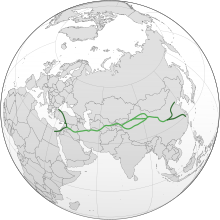
La ropa (también conocida como ropa , prendas de vestir , vestido , indumentaria o atuendo ) es cualquier artículo que se usa sobre el cuerpo . Por lo general, la ropa está hecha de telas o textiles , pero con el tiempo ha incluido prendas hechas de piel de animales y otras láminas delgadas de materiales y productos naturales que se encuentran en el medio ambiente, juntas. El uso de ropa está restringido principalmente a los seres humanos y es una característica de todas las sociedades humanas. La cantidad y el tipo de ropa que se usa depende del género, el tipo de cuerpo, los factores sociales y las consideraciones geográficas. Las prendas cubren el cuerpo, el calzado cubre los pies, los guantes cubren las manos, mientras que los sombreros y los tocados cubren la cabeza y la ropa interior cubre las partes íntimas .
La vestimenta también tiene factores sociales importantes. El uso de ropa es una norma social variable . Puede connotar modestia . Ser privado de ropa frente a otras personas puede ser vergonzoso . En muchas partes del mundo, no usar ropa en público de modo que los genitales , los senos o las nalgas sean visibles podría considerarse una exposición indecente . La zona púbica o la cobertura genital es el mínimo que se encuentra con más frecuencia en todas las culturas y sin importar el clima, lo que implica una convención social como base de las costumbres. La ropa también puede usarse para comunicar estatus social, riqueza, identidad grupal e individualismo. ( Artículo completo... )
Textil es un término general que incluye varios materiales a base de fibras , incluyendo fibras, hilos , filamentos , hilos , diferentes tipos de telas, etc. Al principio, la palabra "textiles" solo se refería a telas tejidas . Sin embargo, el tejido no es el único método de fabricación, y muchos otros métodos se desarrollaron posteriormente para formar estructuras textiles en función de su uso previsto. El tejido de punto y los no tejidos son otros tipos populares de fabricación de telas. En el mundo contemporáneo, los textiles satisfacen lasnecesidades de materiales para aplicaciones versátiles, desde ropa de diario sencilla hasta chalecos antibalas , trajes espaciales y batas de médico . ( Artículo completo... )
Las artes textiles son artes y artesanías que utilizan fibras vegetales , animales o sintéticas para construir objetos prácticos o decorativos. ( Artículo completo... )


_by_Emperor_Huizong.jpg/440px-Court_ladies_pounding_silk_from_a_painting_(捣练图)_by_Emperor_Huizong.jpg)
.jpg/440px-Finlaysonin_kutojia_vuonna_1951._Kuva_Veikko_Kanninen,_Vapriikin_kuva-arkisto._(16248493129).jpg)










Una bandera de barco medieval capturada por las fuerzas de Lübeck en la década de 1420 mostraba los escudos de armas de Dinamarca , Suecia , Noruega y Pomerania . En esa época, Dinamarca, Noruega y Suecia estaban unidas en la Unión de Kalmar . El santo que acompaña a la Virgen María y al niño Jesús es Santiago el Mayor , identificado por su emblema de concha de vieira . La bandera estaba hecha de lino grueso. Todas las figuras e insignias heráldicas se crearon con pintura a base de aceite.

Proyecto Wiki de Artes Textiles
WikiProject Moda • WikiProject Nudos • WikiProject Escultura • WikiProject Artes visuales
¿Qué son los WikiProyectos ?
Los siguientes proyectos hermanos de la Fundación Wikimedia proporcionan más información sobre este tema: